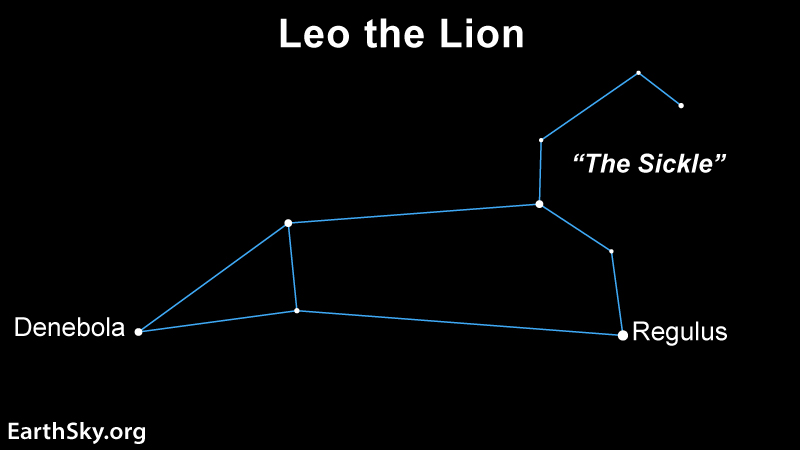
Leo the lion is one of the easiest of the 13 constellations of the zodiac to see. You can start by finding the bright star Regulus. And then trace out a distinctive pattern of stars shaped like a backwards question mark, known as the Sickle.
From a Northern Hemisphere perspective, the Lion is a fair-weather friend, springing into the early evening sky around the March equinox.
In fact, April and May are superb months for identifying Leo the Lion. That’s because this constellation becomes visible as soon as darkness falls and stays out until the wee hours of the morning. Remember, you are looking for a backwards question mark pattern. Also, Leo’s brightest star, Regulus, is a sparkling blue-white beauty of a star, located at the bottom of the backwards question mark. And Regulus depicts the Lion’s heart.
Last chance to get a moon phase calendar! Only a few left. On sale now.
The constellation Leo the Lion
Even though the Sickle is the most obvious pattern in Leo, there’s another distinctive shape in Leo. That’s the triangle of stars in eastern Leo representing the Lion’s hindquarters and tail. The name of the brightest star of that triangle is Denebola, which stems from an Arabic term meaning the Lion’s Tail.
Like all stars, Leo’s stars return to the same place in the sky some four minutes earlier daily or two hours earlier monthly. In early April, the constellation Leo reaches its high point for the night around 10 p.m. local time (11 p.m. local daylight saving time), and starts to sink below the western horizon around 4 a.m. local time (5 a.m. local daylight-saving time). By around May 1, Leo reaches its high point for the night around 8 p.m. local time (9 p.m. local daylight saving time). Also, in early May, the mighty Lion begins to set in the west around 2 a.m. local time (3 a.m. daylight saving time). By June, you’ll find Leo descending in the west in the evening.
Though Leo drifts progressively westward in the early evening sky as the months go by, you can see the Lion in the evening till July. But by late July or early August, the Lion begins to fade into the sunset. And then, from about August 10 to September 16, the sun passes in front of Leo. The constellation returns to the eastern predawn sky in late September or October.
Find Leo by star-hopping from the Big Dipper
If you’re familiar with the Big Dipper star pattern – or asterism – you can star-hop to Leo the Lion every time. After the March equinox, the Big Dipper stands pretty much on its handle in the northeastern sky at nightfall. So at nightfall in April, look for the Big Dipper high in the northeast sky. And at nightfall in May, look for the almost upside-down Big Dipper high in the north, above Polaris, the North Star. Then, identify the two pointer stars of the Big Dipper. Those are the two outer stars in the Big Dipper’s bowl. Now, draw an imaginary line southward toward the stars in Leo.
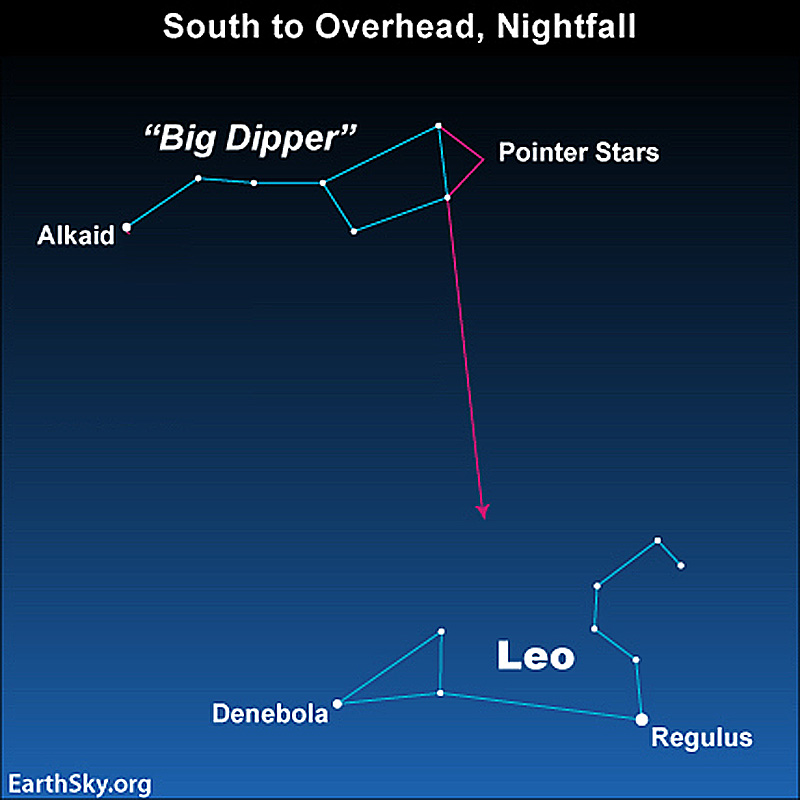
What can you see with a telescope in the Lion?
Check out the chart below to get a sense of the telescopic riches that lie within the boundaries of this constellation.
The star Algieba or γ Leonis is a double star, visible in a small telescope when the atmosphere is steady. If the stars are twinkling wildly, that indicates a turbulent – not steady – atmosphere. On the other hand, if the stars are twinkling very little or not at all, try your luck at splitting Algieba – which looks like a single star to the eye – into its two colorful component stars with the telescope. By the way, you may notice one star appears orangish and the other one appears greenish-yellow.
Also, a close-knit pair of galaxies in Leo provide an inviting target for most telescopes. They are M65 and M66. What’s more, with a low-powered telescope, you might be able to fit both M65 and M66 into a single field of view.
Next, try your luck with a galaxy trio. First, look for M95 and M96. Finally, look for NGC 3628. These three galaxies are known as the Leo Triplet galaxy group.
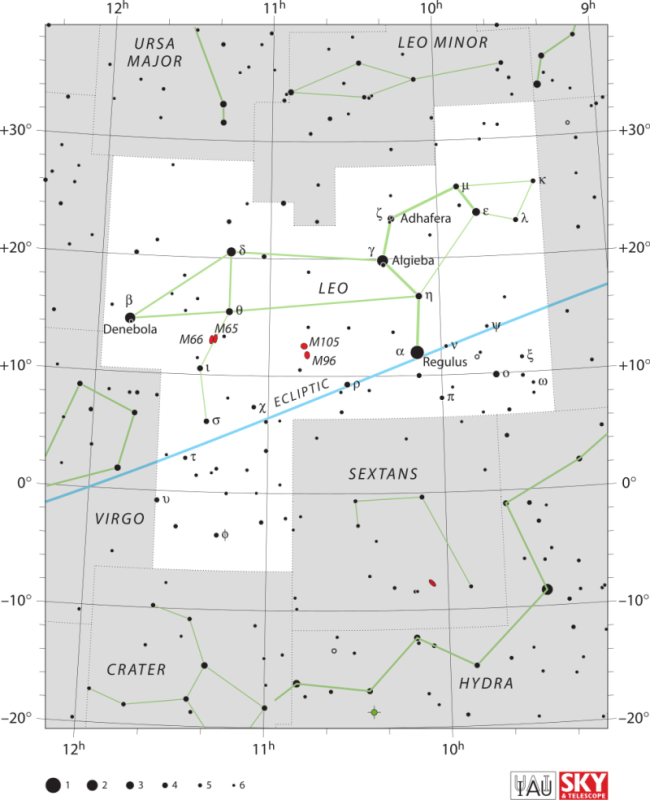
The constellation in history and myth
By the way, Leo the Lion is associated with the sun and has been for epochs. The ancient Egyptians held Leo in the highest esteem. That’s because the sun shone in front of Leo at the time of the annual flooding of the Nile River, the lifeblood of this agricultural nation.
So maybe the various lion-headed fountains designed by Greek and Roman architects symbolize the life-giving waters being released by the sun’s presence in Leo.
Also, in astrology, the sun rules Leo, one of the three fire signs of the Zodiac.
In fact, many stories feature Leo the Lion. Perhaps the two better-known tales feature Heracles’ (also known as Hercules) first labor with the notorious Nemean Lion, and the Roman author Ovid’s rendering of the tragic love affair of Pyramus and Thisbe.
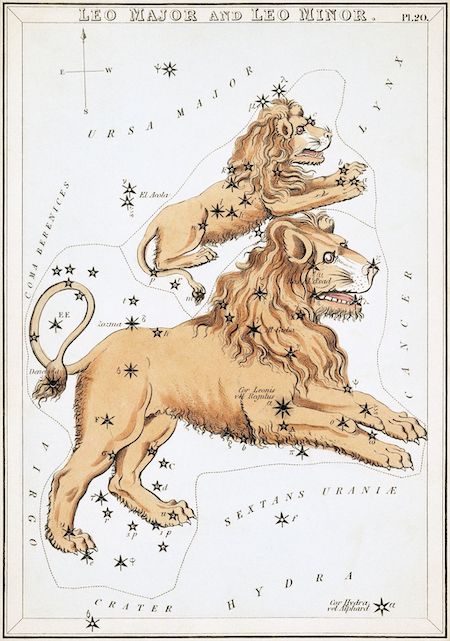
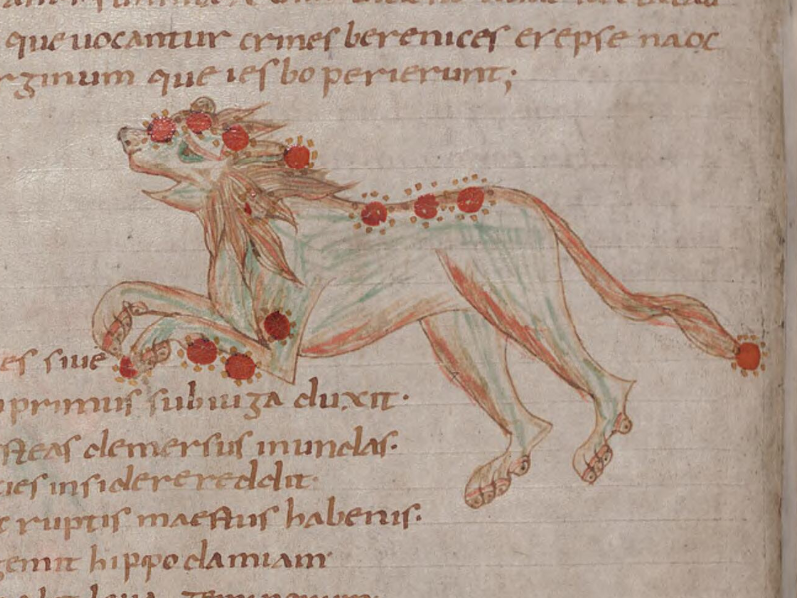
Bottom line: Leo the Lion – one of the zodiacal constellations – is a prominent fixture in the evening sky from April through June. It’s quite easy to spot.
The constellations of the zodiac
Meet Taurus the Bull in the evening sky
Meet Gemini the Twins, home to 2 bright stars
Cancer the Crab and its Beehive Cluster
Leo the Lion and its backward question mark
Virgo the Maiden in northern spring skies
Meet Libra the Scales, a zodiacal constellation
Scorpius the Scorpion is a summertime delight
Sagittarius the Archer and its famous Teapot
Capricornus the Sea-goat has an arrowhead shape
Meet Aquarius the Water Bearer and its stars
Meet Pisces the Fish, 1st constellation of the zodiac
Say hello to Aries the Ram
Born under the sign of Ophiuchus?











